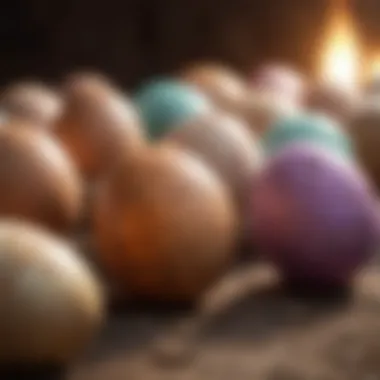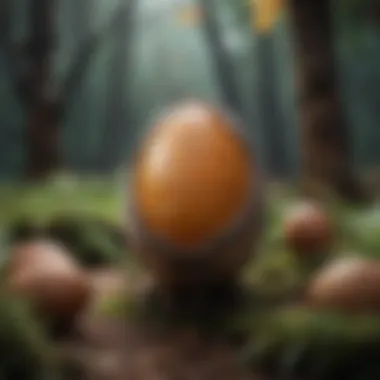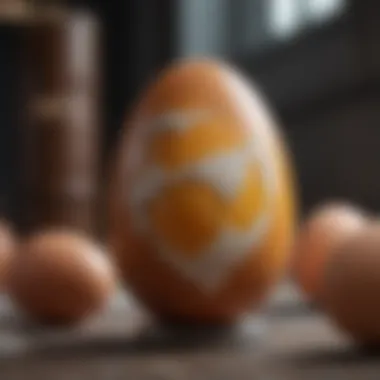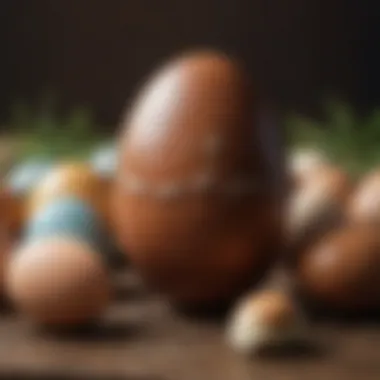Unraveling the Intriguing Connection Between Easter and Eggs


Animal Species Profile
Eggs, an iconic symbol of Easter, have a rich history intertwined with various cultural and religious practices. From ancient pagan traditions to Christian symbolism, the significance of eggs during Easter is a captivating journey encompassing diverse beliefs and rituals. The association of eggs with Easter dates back centuries and is still observed in modern celebrations globally.
Eggs are culturally significant during Easter due to their symbolism of new life and rebirth. In Christianity, eggs represent the resurrection of Jesus Christ, symbolizing hope, renewal, and the promise of salvation. This symbolism aligns with the spring season, where new life emerges, making eggs a fitting symbol for Easter celebrations.
The tradition of decorating eggs during Easter is a widespread custom across cultures. From intricately painted designs to elaborate embellishments, the artistry of egg decoration adds to the festive spirit of Easter. Different regions have unique techniques and styles of egg decoration, showcasing their artistic expressions and cultural heritage.
Unique Facts & Trivia
- Eggs were traditionally dyed red to symbolize the blood of Christ in Orthodox Christian communities.
- The world record for the largest Easter egg hunt included over 500,000 eggs hidden across Cypress Gardens in Winter Haven, Florida.
- In some European countries, rolling eggs down a hill symbolizes the rolling away of the stone from Jesus' tomb.
- The White House Easter Egg Roll is a well-known annual event in the United States that dates back to 1878, involving games and festivities for children.
Intertwined with symbolism, tradition, and artistry, the association of eggs with Easter offers a profound glimpse into the cultural tapestry of this springtime celebration. From their ancient roots to modern-day practices, eggs continue to symbolize the essence of hope, renewal, and the circle of life during Easter festivities.
Introduction
As we embark on the intriguing journey of exploring the enigmatic association between eggs and Easter, it is imperative to delve deep into the historical and cultural tapestry that intertwines these two seemingly disparate elements. The essence of Easter goes far beyond a mere commemoration; it delves into the essence of renewal, rebirth, and the cyclical nature of existence. Eggs, symbolizing fertility and life, have been intricately woven into the fabric of Easter celebrations across various civilizations and belief systems. This article aims to unravel the mystique behind this age-old tradition, shedding light on the interconnectedness of eggs and Easter throughout centuries of human history.
Brief Overview of Easter Celebration
The Easter celebration, embraced by diverse cultures around the globe, stands as a poignant testament to the resilience of tradition amidst the flux of time. Rooted in both ancient rituals and religious observances, Easter marks a period of reflection, redemption, and rejoicing. From the sorrowful solemnity of Good Friday to the jubilant exultation of Easter Sunday, this festivity encapsulates a wide spectrum of human emotions and spiritual contemplation. In essence, Easter symbolizes the triumph of hope over despair, light over darkness, and life over death.
Intriguing Link Between Eggs and Easter


Among the myriad symbols associated with Easter, perhaps none is as enigmatic as the humble egg. The symbolic significance of eggs during this festive season transcends mere culinary delight; it embodies profound allegories of renewal, transformation, and new beginnings. Across ancient civilizations and religious doctrines, eggs have served as potent symbols of life, birth, and the eternal cycle of existence. Unraveling the entwined history of eggs and Easter unveils a rich tapestry of beliefs, practices, and interpretations that resonate deeply with the human psyche.
Purpose of the Article
This article seeks to illuminate the intricate relationship between eggs and Easter, not merely as a historical relic but as a living tradition that continues to reverberate in contemporary society. By delving into the roots of this association and tracing its evolution through time, we aim to provide readers with a nuanced understanding of the symbolic, cultural, and spiritual significance of eggs during Easter. Through this exploration, we aspire to enrich our appreciation of Easter as a mosaic of ancient wisdom, enduring faith, and timeless celebration.
Historical Roots of Easter Eggs
The history of Easter eggs traces back to ancient times, with roots deeply ingrained in various cultures and traditions. Eggs have symbolized new life, rebirth, and fertility across civilizations, making their association with Easter rich in historical significance. Exploring the historical roots of Easter eggs unveils a tapestry of beliefs and practices that reflect humanity's embrace of nature's cycles and spiritual symbolism. As centuries passed, the symbolism attached to eggs evolved, blending pagan rituals with Christian interpretations, adding layers of meaning to this seemingly simple object.
Ancient Origins of Egg Symbolism
The ancient origins of egg symbolism date back to early civilizations, where eggs represented the universe's creation and the beginning of life. Various cultures, such as the Mesopotamians, Egyptians, and Greeks, viewed eggs as a symbol of fertility and renewal. The practice of decorating eggs for religious and cultural purposes was widespread, highlighting the sacredness attributed to this humble yet powerful symbol of life's continuation and abundance.
Pagan Traditions and Fertility Symbolism
Pagan traditions embraced the egg as a potent symbol of fertility, aligning with seasonal celebrations of spring and renewal. The symbolism of eggs in pagan rituals signified the earth's awakening, the return of life after winter's dormancy, and the cycle of birth and growth. Eggs were often painted with vibrant colors and patterns, drawing on nature's hues to honor the interconnectedness between humanity, the natural world, and the divine forces believed to govern life's rhythms.
Christian Adaptation of Egg Symbolism
Within the Christian faith, the adoption of egg symbolism from pagan traditions underwent a transformation, imbuing the egg with new meanings associated with resurrection, redemption, and the promise of eternal life. Early Christian interpretations embraced the egg as a representation of Christ's tomb and his emergence into new life, paralleling the egg's cracking open to reveal life within. This merge of pagan fertility symbols with Christian narratives created a profound metaphorical link between the cycles of nature and the core tenets of Christian belief, enriching Easter celebrations with layers of spiritual depth and cultural continuity.
Cultural Significance of Easter Eggs


The significance of Easter eggs in the cultural realm extends far beyond mere symbolism; it embodies a rich tapestry of traditions and beliefs that have stood the test of time. Eggs, with their universal symbol of fertility and rebirth, hold a central place in the annual Easter celebrations across various cultures. Artists and artisans have captured the essence of Easter eggs in exquisite forms, showcasing the intricate designs and craftsmanship that reflect centuries of cultural heritage and creativity.
Artistic Depictions of Eggs in Easter Celebrations
The artistic representations of eggs in Easter celebrations serve as a visual feast for the eyes, offering a glimpse into the imaginative and symbolic world surrounding this tradition. From elaborate paintings to intricate carvings, artists infuse their creations with layers of meaning, drawing inspiration from folklore, religious narratives, and personal interpretations. Each artistic portrayal not only encapsulates the beauty of the eggs but also conveys deeper messages of hope, renewal, and spirituality.
Egg Dyeing and Decorating Traditions
Symbolism Behind Colors
Delving into the symbolism behind the colors of Easter eggs unveils a world of hidden meanings and cultural significance. Each hue carries a unique symbol, from the purity of white to the vitality of red, symbolizing different aspects of life, spirituality, and humanity. The choice of colors in egg decoration plays a vital role in conveying messages of joy, prosperity, and protection, enriching the Easter festivities with layers of symbolism and tradition.
Techniques and Materials Used
Exploring the techniques and materials employed in egg dyeing and decorating sheds light on the artistry and skill involved in this age-old tradition. From wax resist methods to natural dye sources, each technique showcases a blend of craftsmanship and creativity passed down through generations. The choice of materials, be it organic pigments or innovative tools, adds a contemporary twist to traditional practices, presenting a harmonious fusion of heritage and modernity.
Egg Hunts and Festive Customs
Egg hunts and festive customs epitomize the joy and camaraderie experienced during Easter celebrations. The thrill of searching for hidden treasures, the laughter of children partaking in the hunt, and the shared excitement of discovering colorfully adorned eggs create cherished memories that transcend generations. These customs not only foster a sense of community and togetherness but also instill values of unity, generosity, and the spirit of sharing.
Modern Interpretations and Commercialization
In this section, we delve into the intriguing domain of modern interpretations and commercialization of Easter egg traditions. Throughout history, Easter eggs have evolved from simple symbols to commodities intertwined with consumer culture. The contemporary landscape witnesses a fusion of traditional practices with innovative marketing strategies, shaping consumer perceptions and market trends. The exploration of modern interpretations and commercialization in this article underscores the dynamic nature of Easter egg traditions, shedding light on how ancient customs have transitioned into commercial enterprises catering to a diverse audience eager to partake in seasonal festivities. The significance of this topic lies in acknowledging the metamorphosis of Easter egg traditions from symbolic representations to commercial products, influencing consumer behaviors and redefining the cultural value of these decorative items.


Consumer Trends and Easter Egg Market
Consumer trends play a pivotal role in shaping the Easter egg market, reflecting evolving consumer preferences and purchasing patterns. With the rise of eco-conscious consumers, there is a growing demand for sustainable and ethically-produced Easter eggs, prompting manufacturers to adopt eco-friendly practices and materials. Additionally, the market exhibits a penchant for artisanal and handcrafted Easter eggs, emphasizing quality over quantity. Retailers strategize to capitalize on seasonal trends, offering diverse options ranging from organic, vegan to personalized Easter eggs to cater to a discerning clientele. The Easter egg market thrives on innovation and creativity, with consumers displaying a penchant for unique designs and customized experiences that elevate the traditional Easter egg purchasing journey.
Easter Egg Symbolism in Media and Advertising
The portrayal of Easter egg symbolism in media and advertising serves as a catalyst for consumer engagement and brand storytelling. Marketers leverage the timeless symbolism of Easter eggs to evoke emotions, nostalgia, and cultural significance in their campaigns. Through visual storytelling and creative narratives, brands infuse Easter egg symbolism with contemporary relevance, resonating with audiences on a deeper level. The integration of Easter egg imagery in advertisements transcends traditional marketing tactics, resonating with diverse demographics and fostering brand loyalty through meaningful connections with consumers. The amalgamation of Easter egg symbolism in media and advertising amplifies the festive spirit, creating immersive brand experiences that resonate with audiences on a personal and cultural level.
Evolution of Easter Egg Traditions in the Digital Age
In the digital age, Easter egg traditions undergo a transformative journey, adapting to new technological advancements and digital platforms. Traditional rituals such as egg decorating and hunting experience a virtual renaissance, with the proliferation of online tutorials, virtual egg decorating apps, and social media challenges. The digital landscape offers a virtual space for communities to share their Easter egg traditions, fostering cross-cultural exchanges and collaborative celebrations. Moreover, e-commerce platforms redefine the consumer experience by offering virtual Easter egg shopping experiences, personalized recommendations, and immersive virtual egg hunts. The evolution of Easter egg traditions in the digital age reflects a harmonious blend of traditional customs with modern technological innovations, creating unique and engaging experiences for participants across geographical boundaries.
Interplay of Tradition and Innovation
Maintaining Ancient Customs in Modern Celebrations
Preserving ancient Easter egg customs in modern celebrations presents a unique set of challenges and rewards. As we navigate through the rich history of egg symbolism during Easter, we find ourselves at a crossroads where tradition meets innovation. From the art of egg dyeing to the significance of different colors, maintaining these age-old practices connects us to our cultural heritage while embracing the spirit of creativity. Balancing the old with the new in Easter festivities ensures that future generations can appreciate the depth of symbolism embedded in each handcrafted egg.
Reinterpretation of Egg Symbolism in Contemporary Context
The reinterpretation of egg symbolism in a contemporary context offers fresh perspectives on the age-old traditions associated with Easter. As society evolves, so do our interpretations of symbolism, leading to innovative ways of incorporating eggs into modern celebrations. Exploring the nexus between tradition and creativity allows us to reimagine the role of Easter eggs beyond religious significance, tapping into artistic expressions and personal interpretations. This redefined understanding of egg symbolism paves the way for inclusive and diverse celebrations that resonate with a wide range of audiences.
Challenges and Opportunities in Preserving Easter Egg Traditions
Preserving Easter egg traditions presents both challenges and opportunities in today's fast-paced world. While technological advancements offer new ways to engage with traditional practices, they also pose a threat to the authenticity of age-old customs. Finding the balance between preserving the essence of Easter egg traditions and adapting to modern lifestyles is a delicate act that requires thoughtful consideration. By acknowledging the challenges and embracing the opportunities, we can ensure that Easter egg traditions remain relevant and cherished for generations to come.
Conclusio
With all the information presented throughout this article, it becomes apparent that the association of eggs with Easter extends beyond mere symbolisms and traditions. Through a historical lens, Easter eggs represent a convergence of ancient pagan beliefs, Christian interpretations, and modern commercialization. This union of diverse cultural influences has elevated the status of Easter eggs from simple objects to profound emblems of renewal and hope. By exploring the deep-rooted connection between Easter and eggs, we not only unravel layers of symbolism but also emphasize the enduring significance of this tradition. The evolution of Easter egg customs mirrors the evolution of human beliefs and practices, illustrating how seemingly simple objects can encapsulate complex meanings across different epochs and societies. Acknowledging the importance of this topic in today's context enables us to appreciate the interplay between tradition and innovation in shaping cultural practices.







